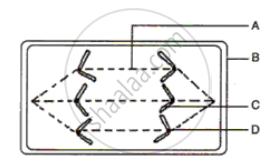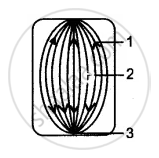Advertisements
Advertisements
Question
The diagram given alongside represents a stage in cell division.
Study the same and answer the questions that follow:

(i) Identify the stage of cell division.
(ii) Name the parts labeled A,B,C and D.
(iii) What is the unique feature observed in this stage?
(iv) Where does this type of cell division usually occur?
(v) How many daughter cells are formed from this type of cell division?
(vi) Is the dividing cell shown a plant or an animal cell?
Give a reason to support your answer.
Solution
(i) Anaphase in a plant cell
(ii) A - Spindle fibre
B - Cell wall
(iii) The homologous daughter chromatids or chromosomes begin to move towards opposite poles.
(iv) This type of cell division occurs usually in the somatic cells.
(v) Two daughter cells are formed from this type of cell division.
(vi) The dividing cell shown is a plant cell because of the presence of cell wall and the absence of centriole.
APPEARS IN
RELATED QUESTIONS
Define the following:
Karyokinesis
Choose the correct answer:
Which division takes most time?
The diagram below represents a certain stage of a cell.
(i) Is it an animal cell or a plant cell ? Give one reason in support of your answer.
(ii) Label the parts numbered 1 – 3.
(iii) Which stage (phase) of mitosis is represented in this diagram
Draw a labeled schematic representation of mitosis cell division.
Choose the Odd One Out
Multiple Choice Question:
The nuclear membrane disappears in
The karyotype (set of chromosomes) shown below is taken from a dividing cell in a certain individual.
(i) Is the individual male or female? Explain your answer.
(ii) How would you expect
(a) a female cell and
(b) sperm cell to differ in chromosome composition?
